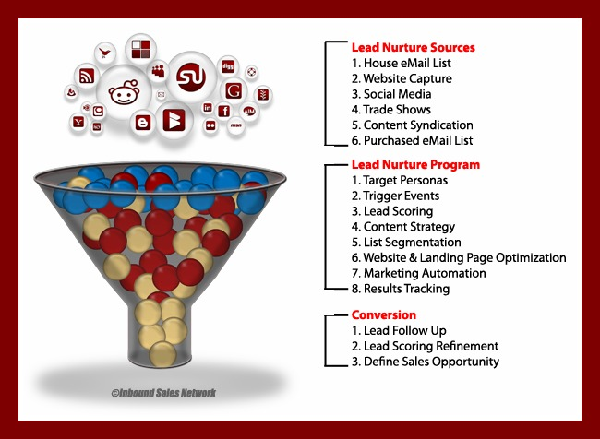Nurturing Your Lead While Juggling All the Advice
By Jaco Grobbelaar on Thu, Dec 01, 2022 @ 01:25 PM

Nurturing your very own personal lead is as much art as science. Advice on this is all over the internet. How do you apply it all? For example, not letting your lead go cold is important to your sales team. Then there are the ways used to describe personal relationship building by “Know, Like, Trust” or “Respect, Trust, Listening”, “How about Listen, Track and Listen Some More, then Learn from Your Mistakes and Adjust.” Much of this you can look at scientifically to see if what you try is working. But to actually nurture your lead by creating a way to hook him and nurture him fall into the art section.
Using scientifically conceived plans involving a sales funnel give you a sense of direction in nurturing your lead. I found this cool model of nurturing your lead broken into three crucial areas in the blog Build a Lead Nurture Program Inbound Sales Network:
Here you see a good plan for what you can do; but you will still need the art to come up with what you need to write, or the pictures you want to use, to nurture your lead. The point is that you do not want your qualified leads to leak, as Lisa Cramer suggests in How to Reduce Lead Leakage Now. Gotta love this picture:
Lisa says “Research shows that nearly 80% of leads that Marketing generates are never worked on by Sales, let alone turned into sales opportunities. Do you ever wonder what happens to those untouched leads? Did they have potential at some point to become opportunities, or were they all just unqualified leads?”
What is that? 80%? How many of these leads could have become customers or clients? This isn’t my idea of a leak; it’s the river gushing over the banks. Having a good plan that could draw people to your sales funnel is not enough to turn a person into client. How can you nurture your lead in such a way that will move her through the funnel?
You can send all the automated emails you want, you can have the best looking website on the block, you can go offline to trade shows, use snail mail or brochures; but if your message does not address your lead’s pain points, you have flunked the art part.
Another great benefit of an effective social media strategy is its ability to promote your brand and build an audience. “Build it and they will come” might make for an inspirational movie tagline, but it doesn’t fly in the digital marketing realm. Once you build it, you must engage your audience and prospective followers.
Fortunately, because of the mind-numbing number of people on social media all over the globe, social media offers a powerful platform for expanding your web presence and building an audience. Social media has become the de facto approach to getting seen and heard in the vast sea of websites on the Internet.
Because click-through rates on links to your website can impact search engine rankings, using effective social media will increases the instances of people clicking on your brand’s content. And this impacts your Google search results.
All you need is love; well maybe.
You have to find ways to nurture or re-nurture your lead. Again you have to apply art to the science. You know what your product or service can do, but do you know how to nurture your lead with it? You have to listen to real people to find out what their pain points are to bait the hook. You do this by creating a persona and then going to where this kind of person hangs out online and see what he is looking for and buying. Check out your competition using Facebook and Twitter. Go look at their websites. You can ask your current customers what they want your service to do or what problem they expect your product to solve. People wanting to grow thicker hair are not going to buy your hair remover.
Then you use what you have learned to creatively help your visitors learn about your business, product or service and how it can ease their pain point. Next, use what you have learned to creatively help your lead identify with, see a need or use for your product. Finally, help your lead come to trust your business, the product and her decision to risk money of it.
This is where the art comes in.
No one can tell you in a blog like this exactly how to create the art portion for your business—how to hook your lead. What you want to say, to portray and how you want to accomplish this are where the art comes in. You will probably learn what to say in nurturing your lead by seeing what others are doing, applying that and using trial and error. You try something on your home page, a blog or a whitepaper. Then, look at analytics and see whether what you have done is successfully nurturing your lead. If it is not, you need to apply art once again and tweak your processes repeatedly until you are satisfied. Don’t forget to keep listening to potential clients and current ones to focus your message to align it ever closer to their pain point.
If you are still not getting the results you want, you might consider hiring a marketing company to help you with the art and the analytics, to follow the steps on the sales funnel, to learn how to gain the trust of your qualified leads and to bring that other 80% though to the other side. A marketing company has a team that will work with you to create a great nurturing your lead project.
If you have questions about nurturing your lead, we at BroadVision Marketing would be glad to answer them.
What have you done successfully to nurture your leads?
You May Also Like
These Related Stories

Plan Your Stay in Touch Campaign to Lead to Conversions

Marketing Strategies: Demand Generation vs. Lead Generation

.png?width=302&height=75&name=BVM%20Logo%20-%20transparent%20(1).png)






No Comments Yet
Let us know what you think